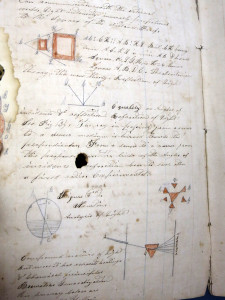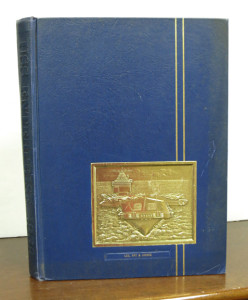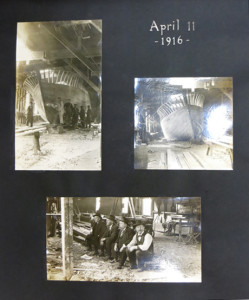We know we’ve been inundating you with blog topics on world class authors, illustrators, artists, and events in history. Is it too much? We thought we’d give you a bit of a reprieve from the education and simply let you read about some new acquisitions we’ve recently catalogued that we are pleased to share with the world. Relax, enjoy, but don’t get too comfortable – I’m sure we’ll be back shoving information down your throats soon enough! (Click on the corresponding images to be taken to the listings on our website.)
 1. The Holly Tree Inn by Charles Dickens: I never understood the phrase “selling like hot cakes” until we got in quite a few of these Peterson’s Cheap Editions of some Dickens titles. We only have a couple left – one this Holly Tree Inn, circa 1867-68, with some average wear (spine rolled, chipping to edges… just look at the picture). This collection of stories began with “The Boots at the Holly Tree Inn” and in 1855 it came out in Household Words as a series of stories about a comfortable and cozy fictitious inn. Our copy still in original publisher’s wrapper with woodcut vignette to front wrapper (get it while it’s hot…).
1. The Holly Tree Inn by Charles Dickens: I never understood the phrase “selling like hot cakes” until we got in quite a few of these Peterson’s Cheap Editions of some Dickens titles. We only have a couple left – one this Holly Tree Inn, circa 1867-68, with some average wear (spine rolled, chipping to edges… just look at the picture). This collection of stories began with “The Boots at the Holly Tree Inn” and in 1855 it came out in Household Words as a series of stories about a comfortable and cozy fictitious inn. Our copy still in original publisher’s wrapper with woodcut vignette to front wrapper (get it while it’s hot…).
2. Richard Halliburton, Adventurer, Archive of Four Letters in Original Envelopes with b/w Photographic Images: Who took the first aerial picture of Mount Everest after receiving express permission by stunning the Majarajah of Nepal with bi-plane aerobatics? Richard Halliburton was a legendary American travel writer and adventurer. Reading stories of his feats and antics seem surreal – after all, who flies an airplane upside down over the Taj Mahal? Richard Halliburton performed many phenomenal (and more than mildly insane) feats over his short life – culminating with a burning desire to sail a Chinese Junk Ship from Hong Kong to San Francisco in 1939. Halliburton oversaw the design and building of a ship for his specific purpose, and the crew got underway. Unfortunately 3 weeks into the journey Halliburton and his crew encountered a typhoon on the open ocean and all were lost at sea. This a collection of the last four letters sent to his fans and investors, from his Chinese Junk project in China, describing the momentously annoying building process (he famous wrote to his followers: “If any one of my readers wishes to be driven rapidly and violently insane, and doesn’t know how to go about it, let me make a suggestion: Try building a Chinese junk in a Chinese shipyard during a war with Japan.”) and the building excitement at the coming voyage.
 3. Manuscript Science Lecture Notes from student P. L. Hinton at Randolph Macon College, 1858: These lecture notes follow a series of lectures by a (Professor) B. Puryear, where the student takes copious notes on subjects from dew on the ground in the morning to temperature (expansion), vaporization, evaporation, electricity, chemistry (hydrogen gas, nitrogen gas, carbon, etc.), the atmosphere, among other scientific things. One of the interesting parts of this school notebook, however, is that at one point Hinton notes a speech, “Delivered before the F. L. Society on the Admission of a new member. Mrs. Tolbert by Willie Star of Richmond City. The Franklin Badge.” Possible secret society, maybe, perhaps? Randolph Macon was founded in 1830 by the Virginia Methodists and is the second oldest Methodist-run college in the country.
3. Manuscript Science Lecture Notes from student P. L. Hinton at Randolph Macon College, 1858: These lecture notes follow a series of lectures by a (Professor) B. Puryear, where the student takes copious notes on subjects from dew on the ground in the morning to temperature (expansion), vaporization, evaporation, electricity, chemistry (hydrogen gas, nitrogen gas, carbon, etc.), the atmosphere, among other scientific things. One of the interesting parts of this school notebook, however, is that at one point Hinton notes a speech, “Delivered before the F. L. Society on the Admission of a new member. Mrs. Tolbert by Willie Star of Richmond City. The Franklin Badge.” Possible secret society, maybe, perhaps? Randolph Macon was founded in 1830 by the Virginia Methodists and is the second oldest Methodist-run college in the country.
 4. USS Enterprise, Navy Cruise Book: Commissioned in 1962, Enterprise was the world’s first nuclear-powered aircraft carrier & the 8th United States naval vessel to bear the name. Like her predecessor of World War II fame, she is nicknamed “Big E”. At 1,123 ft, she is the longest naval vessel in the world, a record which still stands. Enterprise’s crew numbered some 4,600 odd sailors, aviators, et al. 1969 was a fateful year for this ship, as on the 14th of January, a MK-32 Zuni rocket loaded on a parked F-4 exploded after being overheated by an aircraft start unit. The explosion set off fires and additional explosions across the flight deck. This horrific event is pictorially captured in this volume, as well as the crew, ship’s departments, etc, as is the norm for a cruise book such as this. No copies found listed on OCLC.
4. USS Enterprise, Navy Cruise Book: Commissioned in 1962, Enterprise was the world’s first nuclear-powered aircraft carrier & the 8th United States naval vessel to bear the name. Like her predecessor of World War II fame, she is nicknamed “Big E”. At 1,123 ft, she is the longest naval vessel in the world, a record which still stands. Enterprise’s crew numbered some 4,600 odd sailors, aviators, et al. 1969 was a fateful year for this ship, as on the 14th of January, a MK-32 Zuni rocket loaded on a parked F-4 exploded after being overheated by an aircraft start unit. The explosion set off fires and additional explosions across the flight deck. This horrific event is pictorially captured in this volume, as well as the crew, ship’s departments, etc, as is the norm for a cruise book such as this. No copies found listed on OCLC.
 5. [Photograph Album]. Boat Construction in 1916 and The Sunshine: Many photographs in this album were taken by Edwin Levick, a famous boating photographer, most well-known for his many images of years of America’s World Cup races, operating prolifically from the 1910s to the 1940s. Though the first pictures in this book are not attributed to him, it is possible he is the photographer. The first 31 images follow the construction of the powered boat MARIE, from a simple wooden outline of the hull to completion. The last 19 images are of the luxurious SUNSHINE, of it elegantly gliding on the water and its sumptuous interior rooms, from the kitchen to the staterooms and the lifeboat deck. Though no information was able to be found on the SUNSHINE, we can assume these pictures were taken sometime in the early 1920s.
5. [Photograph Album]. Boat Construction in 1916 and The Sunshine: Many photographs in this album were taken by Edwin Levick, a famous boating photographer, most well-known for his many images of years of America’s World Cup races, operating prolifically from the 1910s to the 1940s. Though the first pictures in this book are not attributed to him, it is possible he is the photographer. The first 31 images follow the construction of the powered boat MARIE, from a simple wooden outline of the hull to completion. The last 19 images are of the luxurious SUNSHINE, of it elegantly gliding on the water and its sumptuous interior rooms, from the kitchen to the staterooms and the lifeboat deck. Though no information was able to be found on the SUNSHINE, we can assume these pictures were taken sometime in the early 1920s.
Hope you enjoyed learning about some new items in the Antiquarian Book Trade! Check back in again soon for more exciting blog posts.


